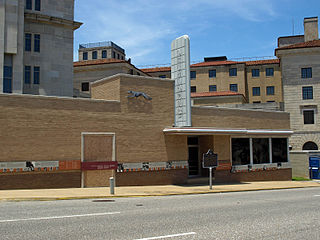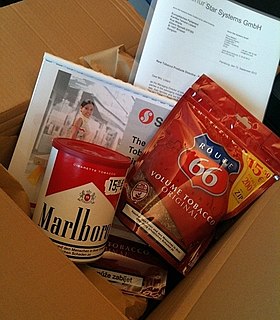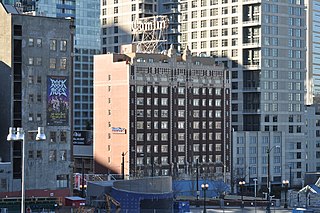
Seattle–Tacoma International Airport, also referred to as Sea–Tac Airport or Sea–Tac, is the primary commercial airport serving the Seattle metropolitan area in the U.S. state of Washington. It is located in the city of SeaTac, approximately 14 miles (23 km) south of Downtown Seattle and 18 miles (29 km) north-northeast of Downtown Tacoma. The airport, the largest in the Pacific Northwest region of North America, is owned and operated by the Port of Seattle.

Greyhound Canada Transportation ULC is the Canadian affiliate of Greyhound USA, and part of the North American operations of FirstGroup.

An intercity bus service or intercity coach service, also called a long-distance, express, over-the-road, commercial, long-haul, or highway bus or coach service, is a public transport service using coaches to carry passengers significant distances between different cities, towns, or other populated areas. Unlike a transit bus service, which has frequent stops throughout a city or town, an intercity bus service generally has a single stop at one location in or near a city, and travels long distances without stopping at all. Intercity bus services may be operated by government agencies or private industry, for profit and not for profit. Intercity coach travel can serve areas or countries with no train services, or may be set up to compete with trains by providing a more flexible or cheaper alternative.
The 2006 Toronto Transit Commission strike was an unlawful wildcat strike in Toronto, Ontario, Canada, that occurred on May 29, 2006. It was initiated by 800 Toronto Transit Commission mechanical and janitorial workers who were protesting proposed changes in work schedules, including permanent reassignment of 100 workers to night shifts. The strike began between 4 a.m. and 5 a.m. EDT, and quickly resulted in a large scale disruption of service when transit drivers honoured the picket line, effectively shutting down the Toronto transit system. The shutdown left over a million commuters searching for alternative means of transport.

The GMC PD-4501 Scenicruiser, manufactured by General Motors for The Greyhound Corporation, was a three-axle monocoque two-level coach used by Greyhound from July 1954 into the mid-70's. 1,001 were made between 1954 and 1956.

Trailways of New York is one of the largest privately held transportation companies based in New York State. It employs over 450 people and carries passengers more than 80 million miles annually.

The Spokane Intermodal Center is an intermodal transport facility located in Spokane, Washington, United States. It serves as a station, re-fueling, and service stop for the Amtrak Empire Builder, as well as the Greyhound, Trailways, and Jefferson Lines station for Spokane. The Empire Builder provides service daily between Chicago, Illinois and Spokane before continuing on to Seattle, Washington or Portland, Oregon.

BoltBus is an intercity bus common carrier that operates low-cost, non-stop and limited-stop, premium level routes in the northeast and western United States and British Columbia, Canada.
The Tennessee Coach Company (TCC) was a regional highway-coach carrier, founded in 1928 and based in Knoxville, Tennessee, USA. It was in operation until 1976, when it became merged into the Continental Tennessee Lines, a subsidiary of the Transcontinental Bus System, called also the Continental Trailways. Continental Trailways was by far the largest member company in the Trailways trade association, which was then named the National Trailways Bus System.

The Greyhound Bus Station at 210 South Court Street in Montgomery, Alabama, was the site of a violent attack on participants in the 1961 Freedom Ride during the Civil Rights Movement. The May 1961 assaults, carried out by a mob of white protesters who confronted the civil rights activists, "shocked the nation and led the Kennedy Administration to side with civil rights protesters for the first time."

Suburban Express is a bus service that provides transport services to students at six universities in the American Midwest, primarily to and from the Chicago area. Airport shuttles are operated under the name "Illini Shuttle". The company contracts buses from other carriers, and is based in Champaign, Illinois.

The Gateway Multimodal Transportation Center, also known as Gateway Station, is a rail and bus terminal station in downtown St. Louis, Missouri. Opened in 2008 and operating 24 hours a day, it serves Amtrak trains and Greyhound and Burlington Trailways interstate buses. Missouri's largest rail transportation station, it is located one block east of St. Louis Union Station.

The Old Greyhound Terminal was a bus terminal serving Greyhound Lines located at 1100 New York Avenue NW in Northwest, Washington, D.C. in the United States operating from 1940 to the 1980s. It was used extensively during World War II to transport servicemen, and played a minor role in the Civil Rights Movement. It was saved through the intervention of preservationists. Most of the building was incorporated in the new 1100 New York Avenue high-rise office building when it was built in 1991.

Travel Washington is an intercity bus operator in the U.S. state of Washington operated by the Washington State Department of Transportation (WSDOT).

Ithaca Bus Station, also referred to as Ithaca Bus Terminal, is an intercity bus station in Ithaca, the county seat and only city in Tompkins County, New York. The station, located west of North Fulton Street between West Seneca Street and West State Street, had been a train station of the Delaware, Lackawanna and Western Railroad until 1942. The station building accommodates waiting area with seats, ticketing and package express office, and restrooms.
The station closed in October 2018 due to construction, retirement of the station operators, and changing infrastructure in the area. Buses are now boarding downtown for the time being until long term plans are made.

Grey Rabbit, also known as Grey Rabbit Camper Tours, was an American company based in the San Francisco Bay Area that operated long-distance bus service from 1971 to 1983. It was one of a few small, long-distance bus companies established in the U.S. in the 1970s that specialized in inexpensive, no-frills, cross-country bus service using old secondhand buses and attracting counterculture passengers. It was the first one, and was also the biggest, best-known, and "most successful" of them in its first several years. A Washington Post columnist in 1978 referred to Grey Rabbit as "the granddaddy" of the five such "alternative" bus companies existing at that time, also known as "underground" bus companies and "hippie bus" companies. It operated mainly in two areas: between California and the Pacific Northwest, and on a cross-country route between San Francisco and New York. Green Tortoise, which was established in 1973 and named after Grey Rabbit, became Grey Rabbit's main competition in the small field, and eventually bought it out.
Martz Group is an apportioned bus company headquartered in Wilkes-Barre, Pennsylvania, operating intercity commuter buses, charter buses, and tours. The company operates Martz Trailways, which is a part of the Trailways Transportation System. Martz Trailways provides intercity commuter bus service from the Wyoming Valley cities of Wilkes-Barre and Scranton and the Pocono Mountains in Northeastern Pennsylvania to New York City and Philadelphia. The company also runs buses connecting Northeastern Pennsylvania to the casinos in Atlantic City, New Jersey and Sands Casino Resort Bethlehem. Martz Group also operates the Gold Line commuter service and Gray Line sightseeing service in Washington, D.C., the National Coach Works in Fredericksburg, Virginia, and the First Class Coach Company Trailways serving Tampa and St. Petersburg in Florida.





















